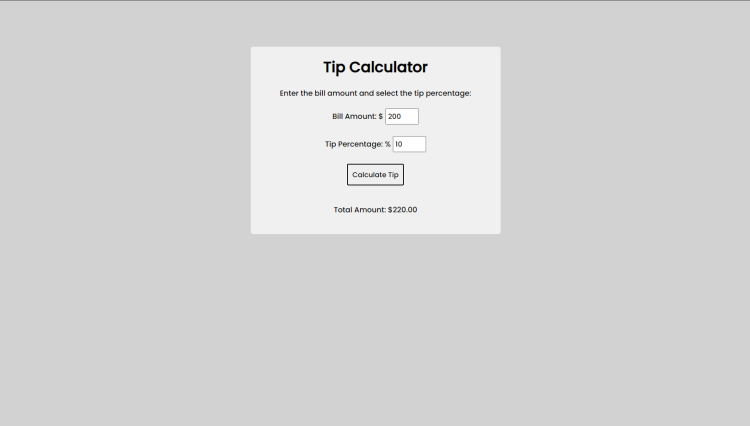Tip Calculator Using HTML, CSS and JavaScript with Source Code
In this project, we'll create a user-friendly Tip Calculator using the dynamic trio of web development: HTML, CSS, and JavaScript. Whether you're dining at a restaurant, ordering takeout, or simply looking to leave a gratuity, this web-based tool will assist you in determining the tip amount for your bill. It's a practical and educational exercise for beginners in web development and a useful utility for anyone looking to calculate tips quickly and accurately.
Our Tip Calculator features a clean and intuitive user interface designed with HTML and styled with CSS. The user can input the bill amount and select the desired tip percentage. Once the "Calculate Tip" button is pressed, the JavaScript function will swiftly compute the tip amount and display the total bill with the tip included.
By the end of this project, you'll have gained hands-on experience in building a simple yet practical web application. You'll learn how to collect user input, perform calculations, and dynamically update the webpage, all while enhancing your knowledge of HTML, CSS, and JavaScript. So, let's dive in and create a Tip Calculator that's both functional and visually appealing!
You may also check other computation apps using JavaScript:
Features of the Tip Calculator:
-
User-Friendly Interface: The Tip Calculator offers a straightforward and visually appealing design, making it easy for users to understand and use.
-
Bill Amount Input: Users can enter the bill amount in dollars using a user-friendly input field. The input field is designed to accept numerical values, ensuring accurate data entry.
-
Tip Percentage Input: Users can select the desired tip percentage using another input field. The Tip Percentage field accepts numerical values as a percentage.
-
Calculate Tip: Upon clicking the "Calculate Tip" button, the JavaScript function is triggered to perform the necessary calculations. If the user input is not valid (e.g., non-numeric values), an alert message will inform the user.
-
Tip Calculation: The script calculates the tip amount by multiplying the bill amount by the selected tip percentage and then displays the result.
-
Total Amount Display: The total bill amount, including the tip, is displayed with precision up to two decimal places. Users can see the final amount they need to pay.
These features ensure that the Tip Calculator is not only functional but also user-friendly and reliable, providing an excellent learning opportunity for web development enthusiasts and a useful tool for anyone in need of quick and accurate tip calculations.
Sample Screenshots of the Project:
Tip Calculator Landing Page

Sample Calculations

How to Run?
- Download the provided source code zip file.
- Extract the downloaded zip file.
- Open the html file and you are now ready to go!
Conclusion
The Tip Calculator project is a practical example of how HTML, CSS, and JavaScript can be seamlessly integrated to create a user-friendly and functional web application. With its clean and intuitive interface, this tool is both visually appealing and easy to use, making it accessible to a wide range of users.
Through this project, we've explored the essential aspects of web development, from collecting user input and performing calculations to dynamically updating the webpage. The Tip Calculator not only serves as a useful utility for calculating tips but also provides an excellent learning experience for those looking to enhance their web development skills.
That's it! I hope this "Tip Calculator Using HTML, CSS and JavaScript" will assist you on your programming journey, providing value to your current and upcoming projects.
For additional tutorials and free source code, explore our websites.
Enjoyyy :>>
Note: Due to the size or complexity of this submission, the author has submitted it as a .zip file to shorten your download time. After downloading it, you will need a program like Winzip to decompress it.
Virus note: All files are scanned once-a-day by SourceCodester.com for viruses, but new viruses come out every day, so no prevention program can catch 100% of them.
FOR YOUR OWN SAFETY, PLEASE:
1. Re-scan downloaded files using your personal virus checker before using it.
2. NEVER, EVER run compiled files (.exe's, .ocx's, .dll's etc.)--only run source code.

